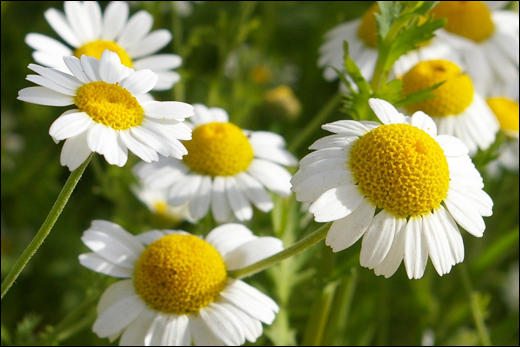Chamomile / Babuna / Matricaria Chamomilla: Health Benefits, Use
Abstract
M. chamomilla is a popular plant distributed worldwide that helps with all kinds of diseases, including infections, pains and other major body disorders. Researchers from several countries found the different chemical compounds that make this plant more beneficial. Since the past few years, traditionally, the various parts (flowers, leaves, whole plant) have been used in the treatment of diabetes, nervous disorders, colic, diarrhoea, painful menstruation, fever, and digestive disorders and taken in the form of decoction and infusion.

Introduction
Chamomile belongs to the family Asteraceae and has two common varieties, namely, German chamomile (Chamomilla recutita) and Roman chamomile (Chamaemelum nobile). It is an annual herb that grows on any type of soil. The chamomile flower contains an array of natural compounds, such as flavonoids, triterpenes and several essential oils. In some ways, the chemical compounds in both types of chamomile may differ. Many people have traditionally used chamomile flower powder to treat various health problems. Chamomile tea is preferred among other herbal teas, as it calms anxiety and cures stomach disturbances quickly.
Systemic Classification
- Kingdom: Plantae
- Phylum: Tracheophyta
- Class: Magnoliopsida
- Order: Asterales
- Family: Asteraceae
- Genus: Matricaria
- Species: Chamomilla
Synonyms Of Chamomile
The two types of chamomile are:
- German chamomile: wild chamomile, Hungarian chamomile, Matricaria, blue chamomile and sweet false chamomile.
- Roman chamomile: English chamomile, sweet chamomile.
Other Vernacular Names
- Hindi Name: Babunekha Phal
- English Name: Chamomile
- Botanical Name: Matricaria chamomilla
- Sanskrit Name: Babunah
Habitat
M. chamomile is found naturally and can be grown in any type of soil. This can grow at a temperature ranging from 7°C – 26°C and starts blooming in the second week of March. This plant grows better in full sun and requires long summer days and high temperatures for yield, but it can also withstand cold weather.
Morphology
- Stem: The branched stem is erect and grows at a height of 10 to 80 cm.
- Flower: The flower heads are pedunculate, heterogamous and placed separately at a diameter of 10- 30 mm. The white ray flower color is 6–11 mm long and 3.5 mm wide, arranged concentrically. Chamomile (Babonj) is most commonly used in its flower form, followed by the leaves and the entire plant.
- Leaf: leaves are bi- to tripinnate and are narrow and long. The leaf arrangement is alternate; that is, there is one leaf per node along the stem.
- Fruit: yellowish – brown cypsela.
Chemical Composition
| Compound | Roman Chamomile | German Chamomile |
| Essential oil components | Less chamazulene, esters of angelic acid, and tigelic acid | Terpenoids alpha- bisabolol, and its oxide azulenes |
| Flavonoids | Apigenin, luteolin, patuletin, quercetin, and naringenin. | |
| Coumarins | Herniarin and umbelliferone | |
| Phenolic Acids | Benzoic and rosamarinic acids | |
| Amino Acids | Proline and alanine |
Practical Uses And Benefits
- The dried flowers of M. chamomile are used in the making of herbal teas and act as anti-inflammatory and antiphalogistic.
- The flavonoid, apigenin present in chamomile, has sedative effects that bind with the receptor in the brain. So it acts as a sleep inducer, treats insomnia and induces calming effects.
- Chamomile herb has also been used in women as a uterine tonic, to treat stomach cramps and back pain, and as an emmenagogue.
- Chamomile extract is also effective in treating common cold symptoms. Putting chamomile flowers in boiling water and inhaling the steam can act as a decongestant, relieving blocked or stuffy noses. They work by reducing swelling of the blood vessels in your nose.
- Chamomile tea is also helpful with gastro intestinal disorders; it can treat the gas, soothe the stomach and relax the muscles that move food through the intestines.
- A tincture of Roman chamomile is helpful in treating hemorrhoids, and by applying the chamomile ointment, this may improve the pile condition. Some studies show that the chamomile extract inhibits Helicobacter pylori, the bacteria that can contribute to stomach ulcers.
- Chamomile oil is a popular ingredient in aromatherapy and hair care, helps clear dandruff and soothes the scalp. Better promotes healthy hair without any harm. Also, Roman chamomile is widely used in cosmetic preparations and soothes and softens the skin.
- Placing the used chamomile tea bags or applying paste under the eyes is helpful in reducing puffiness and dark circles.
- This herb is rich in antioxidants that have anti-aging properties. This can fight free radicals, prevent oxidative damage to the skin, and slow down the process of aging.
Safety Issues With Chamomile
- Many people are sensitive to chamomile herb as they develop allergic reactions, Few species of the Compositae family induce allergic reactions.
- The excessive use of this herb can be bad, so people must be aware of there body type so that it can prevent weird reactions.
- And it is a sedative herb, so alcoholic consumption must be avoided.
- Any herbal medication should only be used under the supervision of physician.
- Safety procedures must be followed with young children, pregnant or nursing women, or patients with liver or kidney disease.
Parts Used
Whole plant
Conclusion
There are so many therapeutic herbs that have been used traditionally for medicinal purposes. They possess the chemical constituents which have the ability to fight against with the disease and act as antiseptic, antioxidant rich, anti-inflammatory, anti-cancer, anti-diabetic, and other effective uses. The chamomile can easily be taken in the form of tea, and the best topical use is in the form of an ointment or oil that helps in the treatment of psoriasis and eczema. This herb has Ayurvedic importance , has been used since ancient times. One must be aware of the dosage and the type of body. As it is a natural weed, this can cause a few allergic reactions, so safety precautions are mandatory before use.

